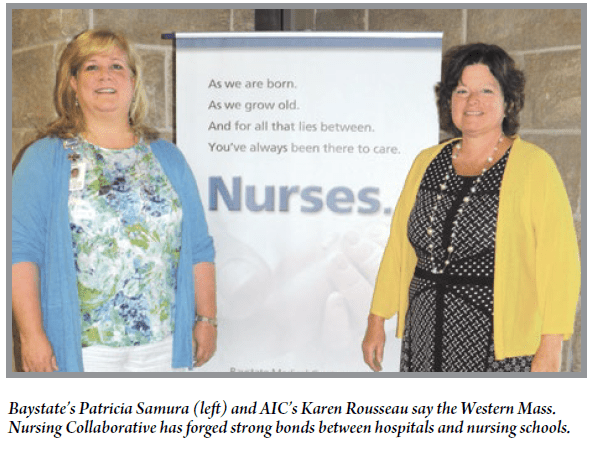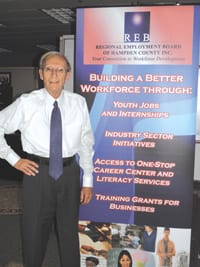Round table Refinements – Healthcare Workforce Partnership Aligns
Anticipating the workforce needs of healthcare providers five, 10, or 20 years down the road doesn’t require a crystal ball. It does require forward thinking, initiative, and effective partnerships between the many players involved with creating a large, effective workforce. And these are the ingredients that go into the Healthcare Workforce Partnership of Western Mass., an arm of the Regional Employment Board of Hampden County.
Dramatic changes are expected to take place in the field of healthcare and the way it is delivered over the next five years. But graduates from local colleges should be well prepared to fill the needs of regional employers, thanks to the Healthcare Workforce Partnership of Western Mass., an arm of the Regional Employment Board of Hampden County, or REB.
“Our partners come together to think through strategies to respond to ever-changing workforce needs,” said David Cruise, the REB’s president and CEO. “Part of the challenge is to be forward-thinking, innovative, and able to anticipate and balance supply versus demand within the healthcare workforce sector.”
The partnership has two divisions: the Western Mass. Nursing Collaborative, composed of employers and nursing school deans, directors, and faculty members; and the Allied Health Committee, which includes employers, educators, training providers, one-stop career centers, and project managers and personnel. They have each collaborated on a number of new programs and initiatives that Cruise believes are making a difference in educating, attracting, and retaining qualified healthcare professionals.
One of the workforce partnership’s current projects is an on-the-job training program that allows new hires to earn while they learn, and provides them with the knowledge or skills needed to succeed in their specific position. It’s funded through a two-year grant, and reimburses employers 50{06cf2b9696b159f874511d23dbc893eb1ac83014175ed30550cfff22781411e5} of the workers’ salaries during a pre-set training period that cannot exceed 20 weeks.
Cruise said the first year was spent developing the program with employers. And although the wage reimbursement offsets the cost of the additional training the program provides, employers say it’s a secondary benefit.
“They believe it’s an efficient way to find good candidates and regard the reimbursement simply as a value added,” Cruise told HCN as he talked about the process of selecting and presenting employers with a pool of qualified job applicants.
They come from a variety of venues, and a significant number are referred by local colleges. Others come from the one-stop career centers (FutureWorks and Career Point) which conduct assessments before choosing candidates, while the remainder apply directly for advertised positions in a traditional manner.
However, a large percentage have some clinical experience, because the grant can only be used to fund training for nurses or people in allied healthcare fields, and each employer has to provide the REB with a monthly progress report on their new hires.
Although the grant limits what professions are eligible for reimbursement, the program was enhanced in late June by a $25,000 grant from Bank of America that does not specify what jobs it can be used for.
“It will offer us greater flexibility and can be cobbled with other grants,” Cruise explained. “The REB is matching the $25,000, and the money will provide reimbursements for 10 new employees in nursing, medical assisting, health information technology, medical billing/coding, and other positions that include pharmacy technicians and community health workers.
“We’re trying to shorten the recruitment period for employers with this program,” he went on. “They have complete authority over the final hires, and this is putting people to work and giving them opportunities.”
Targeting Young People
The Healthcare Workforce Partnership works on many fronts, but has prioritized its goals, said Cruise.
They include creating more workforce diversity in Hampden, Franklin, and Hampshire counties; educating more advanced nurse practitioners and physician assistants; the formation of a Career Pathways Initiative that brings together high schools and community colleges to create industry-specific programs that align education, training, and employment opportunities for today’s youth; support for new graduates as they transition into jobs; and education that promotes team-based healthcare.
Cruise said Chicopee Comprehensive High School and Holyoke Community College are piloting a Pathways to Prosperity Health Sciences program that is similar to a grade-9-to-14 career path model that was launched several years ago at West Springfield High School to fill jobs in the precision manufacturing sector.

The impetus began after Cruise contacted Kenneth Widelo, Comp’s career and technical education director, and explained the grade-9-to-14 model, then met with officials from Holyoke Community College (HCC) and set up a meeting between the two schools.
“It quickly became obvious that a program could be mutually beneficial, and although there wasn’t any funding to create a healthcare model, they felt it was so important that they cobbled resources to make it work,” said Cruise.
Widelo said they had several meetings with representatives from HCC to create an appropriate curriculum before the program was launched. “We had researched healthcare-delivery systems used by other vocational technical schools, but they all put students into one very specific track, such as working as a certified nursing assistant,” he told HCN, adding that their goal was to offer a broader range of options.
The pilot program kicked off two years ago with 10th graders, which allowed the high school to make refinements to the curriculum. It has been highly successful, and allows students to earn 21 credits at HCC before they graduate high school.
“After they matriculate, they can transfer to the community college or attend a four-year college and go into nursing, work to become a doctor, or pursue a degree in healthcare business management,” Widelo said, noting that internships are part of the curriculum.
However, both schools are looking forward to the fall semester, which will mark the first class of incoming freshmen in their newly created Medical Science Academy, which is in line with the grades-9-to-14 career pathway they set out to establish.
Wideo said recruitment efforts for participants involved a variety of measures. Students from the city’s two middle schools completed a career-assessment survey, and two career counselors talked with them, then worked with the middle school guidance departments to identify interested candidates. They were interviewed, and a group of 40 graduating eighth-graders was selected and will begin their course of study this month in HCC’s science laboratory.
“We’re really excited about the program,” said Widelo, adding that students had expressed interest in healthcare careers in the past before the track was created.
Cruise said the students are enthusiastic and understand that the program will help them jumpstart a career.
“The academy has a rigorous academic program that has been aligned with the demands students need to satisfy in order to move seamlessly into an associate-degree program,” he told HCN, noting that the five college courses they take in high school will save each student approximately $3,000 in tuition.
“It’s a model we think could be used by other schools, and once we get the template down, there is no doubt that it could be replicated,” he went on. However, it will require willing partners and involvement by the private sector, which could include summer jobs that bring the students’ academic studies to life.
Filling a Critical Need
The Western Mass. Nursing Collaborative, meanwhile, is also doing its best to guarantee there will be enough well-educated nurses to fill a growing need in Western Mass., which is especially important because registered nurses represent the largest segment of the healthcare workforce.
“They’re working from a set of priorities and updating their strategic plan by setting specific goals,” Cruise noted. “We have more than 40 very active educational institutions and employers who are members, and it’s important to provide a forum for them because the healthcare landscape is changing rapidly. The needs are so dramatic that they have to be innovative and responsive as they make plans to move forward and meet the workforce needs of the future.”
Their priorities include increasing the diversity of the nursing workforce, ensuring that nurses have the competencies and full scope of practice needed to meet the changing health needs of the community; increasing the number of nurses with a bachelor’s degree or higher; increasing the supply and diversity of nursing faculty in area programs and the retention of new nurses in all care settings; and sustaining the partnership.
Patricia Samra, a registered nurse and director of Clinical Workforce Planning and Finance for Baystate Health, said the Western Mass Nursing Collaborative was formed in 2006, thanks to a three-year grant, and was initially called Partners Invested in Nursing. “It focused on workforce initiatives and marked the first time that major healthcare providers and educators in the region convened,” she said, explaining that they included all area schools of nursing along with employers that ranged from hospitals to long-term care providers, who have been working steadily to make sure there is a pipeline of qualified nursing students who are supported after they graduate and get jobs.
The support is imperative, because approximately 30{06cf2b9696b159f874511d23dbc893eb1ac83014175ed30550cfff22781411e5} of nurses leave the profession less than two years after they begin working.
“They burn out due to a lack of confidence,” said Samra, adding that Baystate has created a program to lower that rate.
It brings newly hired nurses together monthly to share emotions as well as clinical challenges, and they are given a case study to analyze, which involves discussing best practices and allows them to reflect on their own experiences.
“They may go into our simulation lab and practice techniques, but the goal is not to gain clinical experience, it’s about critical thinking at the bedside centered around quality care and patient safety,” said Samra, noting that their retention rate has risen significantly since the program began.
Karen Rousseau, director of the Division of Nursing at American International College, says the school works closely with Baystate, and some of its staff members are clinical instructors.
The school also has alliances with other employers, because nursing students have to complete a designated number of clinical hours, which is done in a variety of settings.
“One of the biggest projects our students have been involved with in the past two years is helping patients transition from an acute-care setting to their homes,” said Rousseau, noting that they have shadowed nurses from visiting nurse associations, then worked with the nurses to identify gaps to improve care.
AIC is also a partner in the Health Inter-professional Educators of Pioneer Valley, which seeks to promote communication between students in areas such as ethical dilemmas.
“It grew out of the Cooperating Colleges of Greater Springfield, and encompasses AIC, Western New England University, Elms College, Springfield Technical Community College, HCC, Baypath University, Springfield College, Westfield State University, UMass Amherst, and members from Baystate Medical Center who are interested in supporting interprofessional education and collaboration in health care,” Rousseau said.
Keeping Pace
The programs created by the Healthcare Workforce Partnership of Western Mass under REB’s umbrella ensure that communication takes place between schools, training facilities, and employers. “It’s a challenge to meet the headwinds we are facing, but there is a growing demand for healthcare professionals both at the patient level and away from the bedside,” Cruise noted.
As a result, the collaborations that are formed are taken seriously by members.
“We all believe the partnership is very valuable,” said Samra. “The REB helps get organizations to the table for two to four hours each month, and even though we are all busy, full-time working professionals, it’s worthwhile because it adds value to all of our programs.”
And it also helps ensure a steady flow of workers in the pipeline to meet the growing healthcare needs of this region for years to come.

